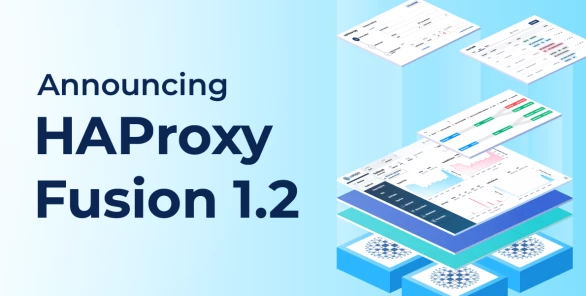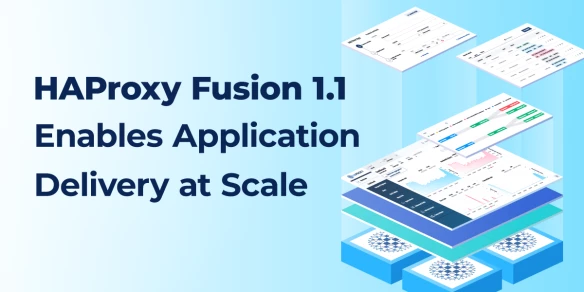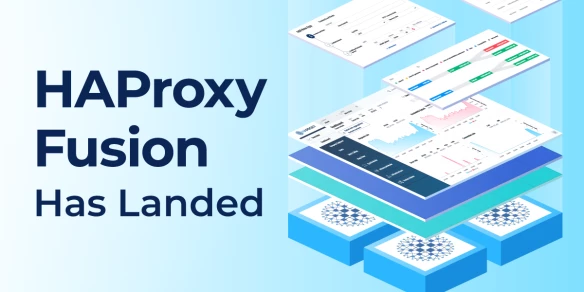
HAProxy Fusion 1.2 is now available, making it even simpler to adopt modern, scalable application delivery. New efficiencies, workflows, and form factors enable you to be more productive, use familiar tools, and explore powerful new use cases.
New to HAProxy Fusion?
HAProxy Fusion provides centralized management, monitoring, and automation of HAProxy Enterprise, enabling efficient operation of a highly-scalable load balancing and WAF layer.
To learn more, contact our sales team for a demonstration.
What’s new?
HAProxy Fusion 1.2 LTS (Long Term Support) is a big release containing many important new capabilities. For the full list of features, log into HAProxy Portal to see the HAProxy Fusion 1.2 Release Notes. Key features include:
Service discovery (Kubernetes and Consul)
Shared files for cluster groups
Automation blueprints
Notify scripts in VRRP
Arbitrary data in Request Explorer
SSL/TLS certificate expiry dates
fusionctl CLI (tech preview)
OVA file for simpler air-gapped deployment
Revamped role-based access control editor
Ready to upgrade?
When you are ready to start the upgrade procedure, log into HAProxy Portal and go to the upgrade instructions for HAProxy Fusion.

New efficiencies for faster, simpler management
HAProxy Fusion makes it easy to manage large-scale deployments of HAProxy Enterprise, saving time and increasing productivity.
Service discovery
HAProxy Fusion now provides service discovery for Kubernetes and Consul environments. You can use this to automate identifying backend services (such as Kubernetes pods) and configuring external traffic routing and load balancing on the HAProxy Enterprise nodes in your deployment.
Service discovery runs continuously, making your configuration dynamic and responsive to backend changes, for example when new pods start in a Kubernetes cluster.
This helps you to manage traffic routing for complex and dynamic backends quickly and easily, saving time and reducing errors.
Service discovery in HAProxy Fusion enables many new use cases, including:
External load balancing for on-premises Kubernetes
Multi-cluster routing and load balancing for Kubernetes
Testing in production (such as blue/green) with multi-cluster Kubernetes
Multi-region failover for Kubernetes clusters in multiple regions or datacenters.
Service discovery for Kubernetes also includes Custom Resource Definitions (CRDs). You can use these to automatically configure the service discovery process right from Kubernetes.
To learn more about these use cases, register for our webinar: “External load balancing and multi-cluster routing for Kubernetes” on December 12th at 11am Eastern / 5pm CET.
Embedded IPAM
HAProxy Fusion now simplifies storing and assigning IP addresses to new frontends with embedded IP address management (IPAM).
You can load a list of IP addresses (list, range, and subnet) for use with frontends/VIPs and ask the IPAM system to assign an IP address and track its use.
This helps simplify and automate managing IP addresses for frontend services exposed on your HAProxy Enterprise nodes. This is integrated with the new service discovery for Kubernetes. By adding an IPAM annotation to a LoadBalancer service it will automatically get an IP address from the IPAM block.
Shared files for cluster groups
HAProxy Fusion allows you to manage and synchronize clusters of HAProxy Enterprise nodes and to manage multiple clusters in “cluster groups”, which together provide multiple layers of control. Many aspects of HAProxy Enterprise management rely on file management, such as ACLs and SSL/TLS certificates.
Previously, if you wanted to replicate files across a cluster group, you had to do this manually. You can now create shared files for all clusters in a cluster group.
This helps you to manage cluster groups more efficiently and reduce errors.
Automation blueprints
HAProxy Fusion allows you to manage and automate configuration for HAProxy Enterprise nodes.
Previously, if you wanted to configure many different services with the same configuration, you would typically need to copy-and-paste the configuration to replicate it. You can now create “automation blueprints” for reusable configuration templates and snippets.
This helps you quickly replicate common elements (such as a common frontend section) and reduce errors.
Arbitrary data in Request Explorer
HAProxy Fusion’s Request Explorer provides a convenient platform for reviewing traffic access logs for valuable insights.
You can now view user-customized data in the Request Explorer. By including user-defined or custom data in request logs, you can tailor the information reported by HAProxy Enterprise to the specific needs of your application.
This helps you make informed decisions and troubleshoot efficiently.
Notify scripts in VRRP configuration
In HAProxy Fusion 1.2, VRRP (Virtual Router Redundancy Protocol) configuration has been enriched with new support for notify scripts.
This support is helpful in scenarios involving cloud-based elastic IPs (EIPs) where users want to rely on an API call to move the EIP to a different instance, maintaining uninterrupted service.
Additionally, notify scripts can send monitoring alerts when instances undergo failovers. This proactive alerting enables you to swiftly address issues, ensuring your infrastructure remains resilient.
SSL/TLS certificate expiry dates
HAProxy Fusion allows you to manage SSL/TLS certificates for HAProxy Enterprise nodes.
You can now view the expiry date and certificate authority (CA) for your certificates.
This helps ensure that you renew certificates at the right time and with the correct CA.

New tools for familiar and flexible workflows
We always intended for HAProxy Fusion to fit seamlessly into your preferred workflow. We launched HAProxy Fusion with an API and a UI, providing enough flexibility for multiple modes of operation and many different workflows. With HAProxy Fusion 1.2, we have added a new interface.
You can now operate many parts of HAProxy Fusion using a new command line interface (CLI) called “fusionctl”.
This is a technical preview of fusionctl and might not be suitable for production use. Functionality is currently limited to clusters, nodes, frontends, backends, binds, and servers. We expect to expand fusionctl to cover more functionality in HAProxy Fusion in future releases.
This new interface:
provides fast access to many objects and configurations
lets you integrate HAProxy Fusion with CI/CD workflows using scripts
enables you to test HAProxy Fusion’s API capabilities quickly before creating a full integration using the API.
If CLI tools such as kubectl are part of your regular workflow, you will feel right at home with fusionctl and the fast, direct access it provides to many configuration objects in HAProxy Fusion. We hope you will enjoy using fusionctl alongside the other interfaces and look forward to your feedback!

New form factor simplifies air-gapped deployment
HAProxy Fusion allows you to deploy your HAProxy Fusion nodes in air-gapped environments where you do not have outbound access to the Internet (for example, for security reasons or because a system needs to be physically isolated).
Previously, air-gapped deployment required a lengthy procedure involving multiple packages. You can now deploy HAProxy Fusion using an OVA file that contains everything you need. This method retains the flexibility to support multiple distributions and automation tools.
This simplifies installation, which saves time and reduces the skill requirement.

New intuitive role-based access control (RBAC) editor
HAProxy Fusion supports role-based access control (RBAC) for secure administration of access privileges and user accounts. The new RBAC editor has an intuitive interface that enhances usability and visibility. Improvements include:
Streamlined role editing, renaming, and duplication when creating and managing roles.
Granular control over resource access.
Search functionality for simple identification of cluster resources.
Edit and filter by cluster and identify relevant resources.
Visibility of inherited and overridden permissions.
Focused filtering that allows users to view:
only resources assigned to a particular role, reducing unnecessary information
session-specific permissions modifications, to review the changes that have been made.
This simplifies role management and helps to reduce potential errors in access.
Conclusion
With new efficiencies, workflows, and form factors, and a new RBAC editor, it's simpler than ever to adopt modern, scalable application delivery.
If you want to see HAProxy Fusion 1.2 in action, contact our sales team for a demonstration.
Subscribe to our blog. Get the latest release updates, tutorials, and deep-dives from HAProxy experts.




